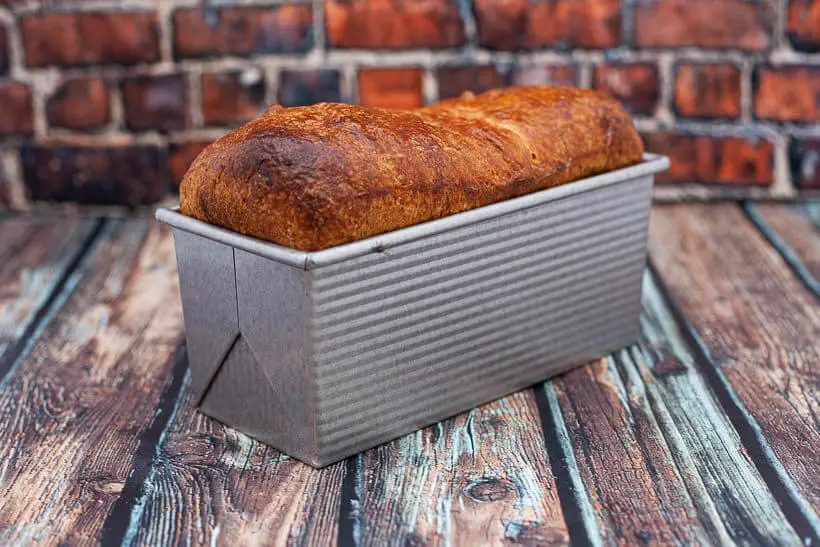You know, sometimes you need a bit of a pick-me-up. You love blueberries. You love anything baked, and, like me, you love butter. Mmmh… Butter! You could make a cake, but you just had cake yesterday, so what will you do? The answer is, of course, my recipe for a blueberry swirl sourdough brioche bread.
Last week I baked sourdough bread with blueberries and lemon. You know, the kind with a chewy crumb and a crispy crust. That was delicious bread, but this time we are going on the opposite side of bread types. The Fluffy McFluffface of fluffy loaves. Dough so enriched that it should be called millionaire’s brioche. Oh my, freakin’ Gawd…

If you are just here for the recipe, you can press the button underneath to be automagically transported to the recipe:
Jump to Recipe Jump to VideoThe history of brioche bread
Wikipedia writes:
The first recorded use of the word in French dates from 1404. It is attested in 1611 in Cotgrave’s A Dictionarie of the French and English Tongues, where it is described as “a rowle, or bunne, of spiced bread” and its origin given as Norman.
It’s a bread that’s developed over the years from a bread that was used in the Catholic church called pain bénit. Over the years, it became increasingly enriched with ingredients such as egg, butter, sugar, and milk.

Historically, two types of brioche were produced:
- Rich man’s brioche (flour: butter ratio, 3:2)
- Pain brioche (flour: butter ratio, 4:1)
Adding butter to this bread helps mask the taste of yeast or sourdough starter in the bread, so there’s absolutely no tang.
The formula in this blueberry swirl sourdough brioche bread recipe
This bread has an exuberant amount of butter. The total flour in the bread is 525g (450g plus 75g in the starter), but the amount of butter is 375g.
A rich man’s brioche has a proportion of 3:2 of flour to butter, so that would make the amount of butter 350g (525 * 2 / 3), so this has an extra 25g added for the love of butter.
| Weight | Ingredient | Baker's Percentage |
|---|---|---|
| 450g | bread flour | 100.0% |
| 200g | eggs | 44.4% |
| 60g | milk | 13.3% |
| 30g | sugar | 6.7% |
| 15g | salt | 3.3% |
| 375g | butter | 83.3% |
As always, you can play around with the formula in my Bread Calculator. Notice that the measurement of the hydration is off, as there is really no way to gauge the hydration in a highly enriched dough.
The feel of the dough seems to be in the 60s range. Slightly tacky but not sticky.

Conclusion on this blueberry swirl sourdough brioche bread recipe
So this is bread is something very special. It is probably the tastiest bread I have ever baked. It isn’t regular bread, though. One that you would eat with meat, cheese, or vegetables. That’s a good thing, or else we wouldn’t eat anything else in my house.
The crust is flaky and deeply caramelized, which makes it insanely satisfying to eat. The crumb is soft, with small holes scattered throughout.

While not having jam everywhere, the swirl leaves a wonderful taste of blueberries in almost every bite.
This bread is an absolute treat. So give it a shot. You’ll be happy that you did!
Please share on social media
This is my recipe for blueberry swirl sourdough brioche bread. I hope you will try to make it. If you make this recipe and post it to Instagram, please tag me as @foodgeek.dk so I can see it. That will make me very happy.
Ad links! Links for equipment and ingredients in this recipe are affiliate links, which means I will get a commission if you purchase the product!

Blueberry Swirl Sourdough Brioche Bread
Ingredients
Dough
- 450 g bread flour
- 150 g sourdough starter fed and grown to its peak
- 4 eggs
- 30 g sugar
- 15 g sea salt
- 60 g milk
- 375 g butter
Blueberry Jam
- 250 g blueberries
- 125 g sugar
- 3 tablespoon cornstarch
- 50 g water
Egg wash
- 1 egg
- 1 tablespoon milk
Instructions
Make the blueberry jam
- Put 250g blueberries in a small pot. Add 125g sugar, 3 tbsps cornstarch and 50g water.
- Mix to combine everything. Bring the mixture to a boil.
- Let simmer for about 10 minutes. Turn off the heat and let the mixture sit in the pan for about 15 minutes to a cool a bit.
- Add the mixture to a bowl and cover with aluminum foil. Let cool in the refrigerator until needed.
Mix the dough
- Mix the dough when your starter is ready. Add 450g bread flour, 150g sourdough starter, 4 eggs, 30g sugar, 15g salt and 60g milk to a bowl.
- Put your index and long finger in the middle of the dough and start moving it in circles; for each revolution, make the circle a little bigger, so you get more and more flour into the fluids.
- Once that gets difficult, grab the back of the dough with your hand, stretch it up and in over the dough, turn the bowl a bit and repeat until all the flour is completely hydrated.
- Leave the dough to rest for 30 minutes under a damp dishtowel.
Bulk fermentation
- Perform four sets of stretch and folds spaced out by 30 minutes.
- Now it's time to add the butter. Put a small handful of cubes on the dough, push it and massage it into the dough. Keep going until you cannot feel any lumps anymore. Then add another handful. Repeat until you have added all the butter.
- Then let the dough ferment until it has expanded by 30-50% in volume.
- Put the dough in the refrigerator for a minimum of 2 hours and a maximum of 48 hours.
Shape and final proof
- Flour your work surface liberally. Dump the dough out and tease it into a rectangle. Roll it out so that it's about the width of your pan minus 1.5cm/½". Roll it thinly, so the dough has to roll several times to be a cylinder.
- Apply the blueberry jam to the dough. You can go to the edge, at the end where you will start rolling, but at the other end, you should leave about 3cm/1" room without any jam. On the sides, you should leave about 1.5cm/½" room without jam.
- Then roll up the dough pretty tightly. When you have a dough roll, fold the ends underneath the bottom to seal the jam inside.
- Grease your tin with butter or baking spray and place the dough in the tin. Then cover the tin with a damp dishtowel and let it proof until it has doubled in size.
Bake the bread
- Heat the oven to 200ºC/390ºF/Gas mark 6.
- Beat one egg with one tablespoon of milk. Brush the bread lightly with the egg wash.
- Bake for about 60 minutes or until the inner temperature reaches 98°C/208ºF. If the bread starts to get too brown during baking, cover it with aluminum foil.
- Once the bread is out of the oven, let it cool for 10 minutes and then take it out of the tin and let it cool completely.











Thanks for the recipe! I’m trying this (without the jam) and am currently waiting for my loaf to finish the final proof. About how long should the bulk ferment take? What about the final proof? Thanks in advance!
It depends on a lot of factors, so go by it growing to the correct size. Bulk can be anywhere from 2 to 8 hours 🙂
How did you incorporate the butter by “massaging “ it into an already formed gluten network?
I managed only 250 g into a 900 g flour recipe…
It starts to melt if you don’t want to get pockets of butter inside.
Have a look at how I do it in the video. It’s one of those things that are hard to put into words 🙂
hi!!! i tried this without the jam… and something went ver wrong. the dough doesn’t grew at all. could it be the sourdough that was weak, could it be because i used salted butter… what do you think? thanks
I love your site and your YouTube channel, Sune! Great job!
Can you please tell me if I can use discard for this recipe?
Hello Sune, great video and recipe, what is the measure of the pan where you made it so I can calculated for my pan. Thank You
Sune, your ingredients list for the blueberry jam calls for 3 tsp of corn starch. Both the video and the mixing instructions say to use 3 tbsp of corn starch. Which is correct? Of course, I used 3 tsp, but in hindsight I think it should have been 3 tsp.
Thanks,
Paul
The blueberry jam says 3tsp of cornstarch in the ingredient list, but 3tbsp in the instruction text. Which is correct, please?
3 tablespoons. I’ve updated the recipe 🙂
I used my stand mixer to work in the butter. I may have overkneaded it – by the time all the butter was in, it had more of the texture of cake batter than bread dough. We’ll see how it rises.
While working it in by hand is a lot of work, you can never overwork the dough 🙂 I hope it turns out.
So, I should’ve known better, but I kneaded the butter in using a stand mixer. Now I have what looks like a butter cake batter. Is this fixable and will it ever work out? Or should I cut my losses, add some sugar and just bake it into a cake?
I am having exactly the same issue. I am adding the butter into the well developed dough and I have only managed to add 50% of the butter for a 900 gr flour recipe. Did you really add all the butter into the dough? It would be great to see the whole sequence of adding the butter, as it is by far the hardest part of this recipe (given the amount).
I can also see some lumps at the end when you stretch the dough to add the marmalade.
Do you know the grams of your eggs? It can be a big difference in 8 eggs if the size from yours to mine vary… much more hydration, harder to add the butter…
Thanks in advance!
The dough is very very heavy and I have done about 6 stretch and folds. I’m thinking iy is not going to work and I need to try agin tomorrow. It never softened enough to really handle well.
What did I do wrong?
Hi Sune what size are your eggs in Denmark? In the UK medium are around 50g but here in South Africa our large are meant to be 51 to 59g. So I would prefer to measure mass. I think that’s done when still in the shell. Thanks
What size pan did you use for this recipe? The picture makes it look larger than a standard Pullman loaf tin.
I used this recipe to make an amazing cinnamon raisin swirl. I wish I could post pictures to show you! Thank you Sune!!!
If you go to my contact page, you can attach a picture there 😀